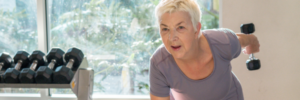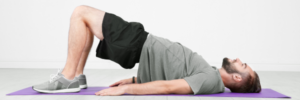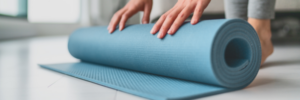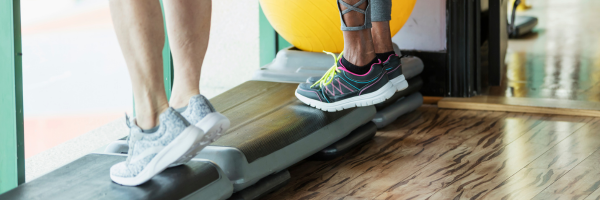Strength training is essential for aging adults to maintain independence. It combats natural muscle deterioration, maintains bodily health into your golden years, and can prevent a number of diseases and conditions related to mobility and weakness.
Osteoporosis
- Inability for the body to generate new bone tissue at the same rate it is removed, resulting in weakened and frail bones.
- Leads to bone fractures and mobility issues.
In an article published by Current Sports Medicine Reports, resistance training is reported to be positively associated with high bone mineral density in both younger and older adults, making it an effective means of preventing and even reversing bone loss after 4 – 24 months of training.
Fibromyalgia
- Prolonged musculoskeletal pain, muscle tenderness, and fatigue.
- Affects about 4 million Americans, or 2% of the adult population, but the cause is widely debated.
Strength training is a scientifically proven method for managing fibromyalgia. According to the evidence found in this study published by Advances in Rheumatology, regular strength training for patients with fibromyalgia resulted in “reduction of pain, fatigue, number of tender points, depression, and anxiety, with increased functional capacity and quality of life.”
Osteoarthritis
- Deterioration of the cartilage that protects joints.
- Results in inflammation, causing joint stiffness, pain, and immobility.
Because most studies of OA treatment focus specifically on the knees, the same evidence-based treatment is applied to other joints such as the hips. In an article published by Annals of Physical and Rehabilitation Medicine, it is found that strength training lower limbs reduced pain and improved physical function in OA patients. Today, it is a common and effective way to manage and slow progression of this condition.
Rheumatoid Arthritis
- An autoimmune disease in which the body attacks its own tissue in the joints, and sometimes other parts of the body.
- Can cause bone erosion and joint deformity, resulting in pain and mobility issues.
In this study published by Clinical Rheumatology, “Long-term [combined strength and endurance training] appears to be effective in reducing disease activity and associated pain and was found to have no deleterious effects.”
Frequently Asked Questions About Strength Training for Seniors
Q1: What is the safest way for seniors to start strength training?
A: The safest way to begin is by starting slowly with low-impact, bodyweight exercises like wall push-ups, glute bridges, or calf raises. Always warm up beforehand, focus on good posture, and check with a healthcare professional before beginning a new program.
Q2: How often should seniors do strength training exercises?
A: Most experts recommend strength training at least two to three times per week. Seniors should aim for 20–30 minutes per session, with rest days in between to allow muscles to recover.
Q3: Do seniors need weights to build strength?
A: No. Bodyweight exercises such as squats, glute bridges, or wall push-ups can be very effective. Over time, seniors may add light weights or resistance bands if they feel comfortable and want to progress further.
Q4: What are the benefits of strength training for seniors?
A: Strength training helps maintain independence, improves balance and posture, supports bone density, reduces the risk of falls, and can even ease age-related conditions like osteoporosis, arthritis, and fibromyalgia.
Q5: Can strength training help prevent falls in older adults?
A: Yes. Strength training improves muscle mass, coordination, and balance, all of which reduce the risk of falls. Stronger leg and core muscles provide better stability for everyday activities.
Q6: Is it safe for seniors with arthritis to do strength training?
A: Yes. In fact, strength training is often recommended to help manage arthritis symptoms. It strengthens the muscles that support joints, reduces stiffness, and improves overall mobility when performed with proper technique.
Q7: What is the difference between strength training and flexibility exercises?
A: Strength training builds muscle and improves bone health, while flexibility exercises increase range of motion and reduce stiffness. Seniors benefit from doing both — strength training for stability and flexibility training for injury prevention.
Amenities That Support Weight-Bearing Exercises
At Simple Life, our North Carolina communities offer many ways to keep fit, including scenic walking trails, a community swimming pool, pickleball courts, a modern fitness facility and yoga studio! Residents have access to training benches, cardio machines, strength training machines. You can use these facilities to perform weight-bearing exercises for seniors with the assistance of friendly staff members. Feel free to find out more about The Hamlet and The Village today!
For any fitness program, you need to consider what you want your long-term goals are. An incredible resource to keep on-hand is the Growing Stronger exercise program published by the CDC, which recommends setting SMART goals: specific, measurable, attainable, relevant, and time-based goals. For example:
- I will commit 30 minutes of my time at least twice a week to working on core strengthening, back strengthening, or leg strengthening exercises for seniors.
- After 12 weeks of strength training, I will walk to the grocery store instead of driving my vehicle.
- I will take the stairs instead of an elevator when possible.
Setting realistic goals is essential for keeping yourself motivated and on-track with your progress! Your goals may change as your body does, which is normal – it’s good to pursue at least five goals at any given time during your training.
Always Warm Up Before Your Workout
Don’t forget to warm-up! Even going for a brisk 5-minute walk will increase your heart rate, temperature, and blood flow. These reactions provide more oxygen for your muscles, which are necessary for safe and productive workout sessions.
Strength Training Exercises for Seniors to Try
You won’t need any weights or other equipment for these exercises since your resistance will come from your own bodyweight (but are just as effective!)
Calf Raises
Targeted Muscles: inner and outer calves and ankles.
Benefit: improves ankle stability and balance.
Stand up straight with feet directly under your hips. Push up slowly through the balls of your feet until you are standing on your toes, then slowly come back down until your heel is touching the floor. Repeat.
Modification: for a more challenging calf raise, lift one leg and perform raises with the other. 
Good Mornings
Targeted Muscles: lower back, glutes, and hamstrings.
Benefit: increases leg and back strength.
Stand up straight with feet directly under your hips. Tighten your core, place your hands behind your head, and make sure your spine is straight. Keep your spine aligned and push your butt out as you bend down to a 90-degree angle. Come back up slowly to the original position. Repeat.
Modification: if you have difficulty maintaining your balance during this exercise, try it with a slight bend to your knees. You can also widen your stance for increased stability.
Glute Bridges
Targeted muscles: glutes, lower back, abdominal muscles, and hamstrings.
Benefit: strengthens muscles that support the spine, resulting in better posture.
This is one of the best posture exercises for seniors. Start by laying down on your back. Bend your knees and keep your feet flat on the floor. Press your lower back into the floor, lay your arms by your side with palms facing down, and begin by slowly raising your pelvis off the floor. Your body should form a straight line from your knees to your chest. Slowly come back down, grazing the floor with your lower back, keeping your core muscles tight. Repeat.
Wall Push-Ups
Targeted muscles: pectoral muscles, arms, and back.
Benefit: increases stability, posture, and arm strength.
Stand with palms against the wall at arm’s length away, slightly wider than shoulder-width apart. With your feet slightly apart and keeping your spine straight, slowly bend your arms and bring your face toward the wall without touching it. Straighten your arms and return to the original position.
For all of these exercises, be sure to maintain good posture and control. Remember to start slow – we recommend doing about three sets of 10 – 15 reps for each exercise, but you can decrease or increase the number of reps and sets you perform depending on what feels good to your body. It’s okay to feel sore, but stop if you’re in pain. 
While strength training, do not leave out flexibility and range-of-motion exercises – these will prevent accidental injury while exercising, and can feel therapeutic on tight muscles. Stretching is great for cooling down after your workout. Try reaching down to touch your toes and stretch the backs of your legs. You can perform butterfly stretches to loosen your hip flexors. To elongate the muscles in your upper arms, reach one arm across your chest with the other holding it at the elbow. Remember to breathe whenever your head is below your heart when you stretch and exercise. Otherwise, you may feel dizzy when standing upright.
Age-Related Diseases and Conditions that Benefit from Strength Training
Strength training is essential for aging adults to maintain independence. It combats natural muscle deterioration, maintains bodily health into your golden years, and can prevent a number of diseases and conditions related to mobility and weakness.
Osteoporosis
- Inability for the body to generate new bone tissue at the same rate it is removed, resulting in weakened and frail bones.
- Leads to bone fractures and mobility issues.
In an article published by Current Sports Medicine Reports, resistance training is reported to be positively associated with high bone mineral density in both younger and older adults, making it an effective means of preventing and even reversing bone loss after 4 – 24 months of training.
Fibromyalgia
- Prolonged musculoskeletal pain, muscle tenderness, and fatigue.
- Affects about 4 million Americans, or 2% of the adult population, but the cause is widely debated.
Strength training is a scientifically proven method for managing fibromyalgia. According to the evidence found in this study published by Advances in Rheumatology, regular strength training for patients with fibromyalgia resulted in “reduction of pain, fatigue, number of tender points, depression, and anxiety, with increased functional capacity and quality of life.”
Osteoarthritis
- Deterioration of the cartilage that protects joints.
- Results in inflammation, causing joint stiffness, pain, and immobility.
Because most studies of OA treatment focus specifically on the knees, the same evidence-based treatment is applied to other joints such as the hips. In an article published by Annals of Physical and Rehabilitation Medicine, it is found that strength training lower limbs reduced pain and improved physical function in OA patients. Today, it is a common and effective way to manage and slow progression of this condition.
Rheumatoid Arthritis
- An autoimmune disease in which the body attacks its own tissue in the joints, and sometimes other parts of the body.
- Can cause bone erosion and joint deformity, resulting in pain and mobility issues.
In this study published by Clinical Rheumatology, “Long-term [combined strength and endurance training] appears to be effective in reducing disease activity and associated pain and was found to have no deleterious effects.”
Frequently Asked Questions About Strength Training for Seniors
Q1: What is the safest way for seniors to start strength training?
A: The safest way to begin is by starting slowly with low-impact, bodyweight exercises like wall push-ups, glute bridges, or calf raises. Always warm up beforehand, focus on good posture, and check with a healthcare professional before beginning a new program.
Q2: How often should seniors do strength training exercises?
A: Most experts recommend strength training at least two to three times per week. Seniors should aim for 20–30 minutes per session, with rest days in between to allow muscles to recover.
Q3: Do seniors need weights to build strength?
A: No. Bodyweight exercises such as squats, glute bridges, or wall push-ups can be very effective. Over time, seniors may add light weights or resistance bands if they feel comfortable and want to progress further.
Q4: What are the benefits of strength training for seniors?
A: Strength training helps maintain independence, improves balance and posture, supports bone density, reduces the risk of falls, and can even ease age-related conditions like osteoporosis, arthritis, and fibromyalgia.
Q5: Can strength training help prevent falls in older adults?
A: Yes. Strength training improves muscle mass, coordination, and balance, all of which reduce the risk of falls. Stronger leg and core muscles provide better stability for everyday activities.
Q6: Is it safe for seniors with arthritis to do strength training?
A: Yes. In fact, strength training is often recommended to help manage arthritis symptoms. It strengthens the muscles that support joints, reduces stiffness, and improves overall mobility when performed with proper technique.
Q7: What is the difference between strength training and flexibility exercises?
A: Strength training builds muscle and improves bone health, while flexibility exercises increase range of motion and reduce stiffness. Seniors benefit from doing both — strength training for stability and flexibility training for injury prevention.
Amenities That Support Weight-Bearing Exercises
At Simple Life, our North Carolina communities offer many ways to keep fit, including scenic walking trails, a community swimming pool, pickleball courts, a modern fitness facility and yoga studio! Residents have access to training benches, cardio machines, strength training machines. You can use these facilities to perform weight-bearing exercises for seniors with the assistance of friendly staff members. Feel free to find out more about The Hamlet and The Village today!
If you’ve heard of squats, lunges, or push-ups, you’re already familiar with the concept of strength training. Strength training may sound intimidating, but it’s quite simple: it involves practicing exercises to target and strengthen certain muscle groups. Strength training has a lot of benefits, especially for aging adults, and doesn’t require much time or equipment. In this post, we will explore safe weight bearing exercises for seniors that can help achieve your fitness goals as well as improve overall well-being.
There are a lot of basic, everyday tasks that require some degree of strength. These abilities, however, are often taken for granted. For example, these tasks may involve carrying bags of groceries or putting them away. Household chores like laundry and general cleaning may require bending down, moving back and forth, pushing, and pulling. These activities may become increasingly challenging as we age due to the involuntary loss of muscle during the aging process. According to a research article published in the National Library of Medicine, muscle mass decreases about 3-8% each decade after age 30. This decline is also know as sarcopenia, which may accelerate after age 60 – this is a large risk to older adults because it increases their risks to falls, injury, or other disabilities.
Before trying out any bodyweight exercises for seniors, we’ll outline what your goals should look like, what you’ll need for working out, and discuss some specific age-related diseases and conditions that can be eased with strength training.
Setting Senior-Friendly Fitness Goals – You Can Do It!
For any fitness program, you need to consider what you want your long-term goals are. An incredible resource to keep on-hand is the Growing Stronger exercise program published by the CDC, which recommends setting SMART goals: specific, measurable, attainable, relevant, and time-based goals. For example:
- I will commit 30 minutes of my time at least twice a week to working on core strengthening, back strengthening, or leg strengthening exercises for seniors.
- After 12 weeks of strength training, I will walk to the grocery store instead of driving my vehicle.
- I will take the stairs instead of an elevator when possible.
Setting realistic goals is essential for keeping yourself motivated and on-track with your progress! Your goals may change as your body does, which is normal – it’s good to pursue at least five goals at any given time during your training.
Always Warm Up Before Your Workout
Don’t forget to warm-up! Even going for a brisk 5-minute walk will increase your heart rate, temperature, and blood flow. These reactions provide more oxygen for your muscles, which are necessary for safe and productive workout sessions.
Strength Training Exercises for Seniors to Try
You won’t need any weights or other equipment for these exercises since your resistance will come from your own bodyweight (but are just as effective!)
Calf Raises
Targeted Muscles: inner and outer calves and ankles.
Benefit: improves ankle stability and balance.
Stand up straight with feet directly under your hips. Push up slowly through the balls of your feet until you are standing on your toes, then slowly come back down until your heel is touching the floor. Repeat.
Modification: for a more challenging calf raise, lift one leg and perform raises with the other. 
Good Mornings
Targeted Muscles: lower back, glutes, and hamstrings.
Benefit: increases leg and back strength.
Stand up straight with feet directly under your hips. Tighten your core, place your hands behind your head, and make sure your spine is straight. Keep your spine aligned and push your butt out as you bend down to a 90-degree angle. Come back up slowly to the original position. Repeat.
Modification: if you have difficulty maintaining your balance during this exercise, try it with a slight bend to your knees. You can also widen your stance for increased stability.
Glute Bridges
Targeted muscles: glutes, lower back, abdominal muscles, and hamstrings.
Benefit: strengthens muscles that support the spine, resulting in better posture.
This is one of the best posture exercises for seniors. Start by laying down on your back. Bend your knees and keep your feet flat on the floor. Press your lower back into the floor, lay your arms by your side with palms facing down, and begin by slowly raising your pelvis off the floor. Your body should form a straight line from your knees to your chest. Slowly come back down, grazing the floor with your lower back, keeping your core muscles tight. Repeat.
Wall Push-Ups
Targeted muscles: pectoral muscles, arms, and back.
Benefit: increases stability, posture, and arm strength.
Stand with palms against the wall at arm’s length away, slightly wider than shoulder-width apart. With your feet slightly apart and keeping your spine straight, slowly bend your arms and bring your face toward the wall without touching it. Straighten your arms and return to the original position.
For all of these exercises, be sure to maintain good posture and control. Remember to start slow – we recommend doing about three sets of 10 – 15 reps for each exercise, but you can decrease or increase the number of reps and sets you perform depending on what feels good to your body. It’s okay to feel sore, but stop if you’re in pain. 
While strength training, do not leave out flexibility and range-of-motion exercises – these will prevent accidental injury while exercising, and can feel therapeutic on tight muscles. Stretching is great for cooling down after your workout. Try reaching down to touch your toes and stretch the backs of your legs. You can perform butterfly stretches to loosen your hip flexors. To elongate the muscles in your upper arms, reach one arm across your chest with the other holding it at the elbow. Remember to breathe whenever your head is below your heart when you stretch and exercise. Otherwise, you may feel dizzy when standing upright.
Age-Related Diseases and Conditions that Benefit from Strength Training
Strength training is essential for aging adults to maintain independence. It combats natural muscle deterioration, maintains bodily health into your golden years, and can prevent a number of diseases and conditions related to mobility and weakness.
Osteoporosis
- Inability for the body to generate new bone tissue at the same rate it is removed, resulting in weakened and frail bones.
- Leads to bone fractures and mobility issues.
In an article published by Current Sports Medicine Reports, resistance training is reported to be positively associated with high bone mineral density in both younger and older adults, making it an effective means of preventing and even reversing bone loss after 4 – 24 months of training.
Fibromyalgia
- Prolonged musculoskeletal pain, muscle tenderness, and fatigue.
- Affects about 4 million Americans, or 2% of the adult population, but the cause is widely debated.
Strength training is a scientifically proven method for managing fibromyalgia. According to the evidence found in this study published by Advances in Rheumatology, regular strength training for patients with fibromyalgia resulted in “reduction of pain, fatigue, number of tender points, depression, and anxiety, with increased functional capacity and quality of life.”
Osteoarthritis
- Deterioration of the cartilage that protects joints.
- Results in inflammation, causing joint stiffness, pain, and immobility.
Because most studies of OA treatment focus specifically on the knees, the same evidence-based treatment is applied to other joints such as the hips. In an article published by Annals of Physical and Rehabilitation Medicine, it is found that strength training lower limbs reduced pain and improved physical function in OA patients. Today, it is a common and effective way to manage and slow progression of this condition.
Rheumatoid Arthritis
- An autoimmune disease in which the body attacks its own tissue in the joints, and sometimes other parts of the body.
- Can cause bone erosion and joint deformity, resulting in pain and mobility issues.
In this study published by Clinical Rheumatology, “Long-term [combined strength and endurance training] appears to be effective in reducing disease activity and associated pain and was found to have no deleterious effects.”
Frequently Asked Questions About Strength Training for Seniors
Q1: What is the safest way for seniors to start strength training?
A: The safest way to begin is by starting slowly with low-impact, bodyweight exercises like wall push-ups, glute bridges, or calf raises. Always warm up beforehand, focus on good posture, and check with a healthcare professional before beginning a new program.
Q2: How often should seniors do strength training exercises?
A: Most experts recommend strength training at least two to three times per week. Seniors should aim for 20–30 minutes per session, with rest days in between to allow muscles to recover.
Q3: Do seniors need weights to build strength?
A: No. Bodyweight exercises such as squats, glute bridges, or wall push-ups can be very effective. Over time, seniors may add light weights or resistance bands if they feel comfortable and want to progress further.
Q4: What are the benefits of strength training for seniors?
A: Strength training helps maintain independence, improves balance and posture, supports bone density, reduces the risk of falls, and can even ease age-related conditions like osteoporosis, arthritis, and fibromyalgia.
Q5: Can strength training help prevent falls in older adults?
A: Yes. Strength training improves muscle mass, coordination, and balance, all of which reduce the risk of falls. Stronger leg and core muscles provide better stability for everyday activities.
Q6: Is it safe for seniors with arthritis to do strength training?
A: Yes. In fact, strength training is often recommended to help manage arthritis symptoms. It strengthens the muscles that support joints, reduces stiffness, and improves overall mobility when performed with proper technique.
Q7: What is the difference between strength training and flexibility exercises?
A: Strength training builds muscle and improves bone health, while flexibility exercises increase range of motion and reduce stiffness. Seniors benefit from doing both — strength training for stability and flexibility training for injury prevention.
Amenities That Support Weight-Bearing Exercises
At Simple Life, our North Carolina communities offer many ways to keep fit, including scenic walking trails, a community swimming pool, pickleball courts, a modern fitness facility and yoga studio! Residents have access to training benches, cardio machines, strength training machines. You can use these facilities to perform weight-bearing exercises for seniors with the assistance of friendly staff members. Feel free to find out more about The Hamlet and The Village today!





